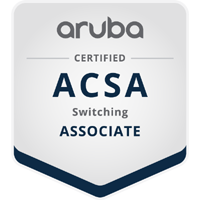Aruba Certified Switching Associate (ACSA) Course Overview
With regard to network switching within Aruba’s networking solutions, the Aruba Certified Switching Associate (ACSA) course is intended to impart fundamental knowledge and abilities. Network fundamentals, TCP/IP stack, Basic networking with Aruba solutions, VLANs, Spanning Tree Protocol, Link aggregation, IP routing, Virtual Router Redundancy Protocol (VRRP), stacking, secure management and maintenance, and Aruba’s management tools like NetEdit and the AOS-CX Mobile App are among the topics that learners learn about through a series of modules. By completing this ACSA Aruba certification course, individuals will be able to configure and manage Aruba’s AOS-CX switches, troubleshoot basic network issues, and ensure secure and efficient network operations. Students who complete the comprehensive curriculum will have the practical skills required to install and maintain contemporary network infrastructures, making them highly marketable in the network engineering and administration fields. In the quickly changing field of networking, the ACSA certification can improve career prospects and provide access to opportunities for advanced study.
Course Prerequisites
Participants in the Aruba Certified Switching Associate (ACSA) Course should be equipped with the following fundamental knowledge and abilities to ensure a fruitful learning experience:
- Fundamental knowledge of network principles and the functions of network equipment like switches, routers, and wireless access points.
- Knowledge of the functions of each layer in the OSI Reference Model as well as its structure.
- An elementary understanding of IP addressing, including IPv4; includes concepts like CIDR notation and subnetting.
- Familiarity with common networking services and protocols, such as DNS, DHCP, TCP, and UDP.
- Knowledge of media, cabling, and Ethernet frames, as well as the Ethernet protocol.
- Basic knowledge of the decimal, hexadecimal, and binary number systems, as well as how to convert between them.
- Awareness of the various forms of network traffic, including multicast, broadcast, and unicast.
Since the course will introduce participants to the Aruba switching portfolio, which includes both AOS switches and AOS-CX switches, no prior experience with ArubaOS-CX switches is necessary.
Please be aware that people who are unfamiliar with Aruba technologies or networking may find this course to be accessible. Although the aforementioned points delineate the bare minimum of knowledge needed, the course material is designed to start with the basics and progress to more advanced ArubaOS-CX Switching topics.
Target Audience for Aruba Certified Switching Associate (ACSA)
For IT professionals, the Aruba Certified Switching Associate course provides extensive training in networking, switching, and IP routing.
- Network Engineers
- System Administrators
- IT Support Technicians
- Network Analysts
- IT Professionals seeking Aruba certification
- Network Designers
- Technical Consultants
- Networking Students and Educators
Learning Objectives – What you will Learn in this Aruba Certified Switching Associate (ACSA)
Course Introduction
During the Aruba Certified Switching Associate course, which covers fundamental networking concepts, Aruba solutions, and important protocols, you can learn the fundamentals of ArubaOS-CX and network switching.
Learning Objectives and Outcomes
- Recognize the basic concepts of networking, such as encapsulation, the OSI model, and the different types of traffic (Unicast, Broadcast, Multicast).
- Discover the TCP/IP stack, which includes IPv4 and TCP/UDP headers, Ethernet frames, and the three-way handshake.
- Discover Aruba’s networking devices and solutions, including AOS and AOS-CX switches, and gain insights into their hardware and software architectures.
- Gain hands-on experience setting up and utilizing VLANs, comprehending their advantages, and controlling broadcast and collision domains.
- Understand how the Spanning Tree Protocol works and how to configure it to avoid L2 loops and maintain network redundancy.
- Learn about load balancing and link aggregation concepts such as static aggregation and LACP.
- Learn about the fundamentals of IP routing, such as inter-VLAN routing, DHCP helper addresses, and default gateways.
- Explore VRRP’s high availability features, including how it operates, how failover occurs, and how it integrates with other protocols such as MSTP.
- Increase your understanding of IP routing by adding subnetting, CIDR, static and dynamic routing, and OSPF route manipulation.
- Examine the advantages, specifications, and configuration of switch stacking technologies like VSF and VSX.

Testimonials
Duke Training Centre Unique Offerings
Online Instructor Led
With the convenience of your home or workplace, you can learn from our knowledgeable trainers online.
Classroom Training
In-person instruction in a physical classroom with maximum interaction at our five-star training facilities.
Schedule Dates
01 November 2024
01 November 2024
01 November 2024
01 November 2024



 Duration
Duration Language
Language Batch Options
Batch Options Upcoming Batch
Upcoming Batch






